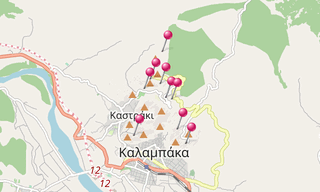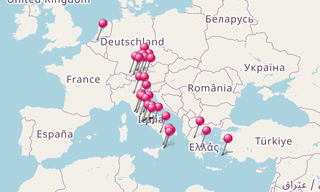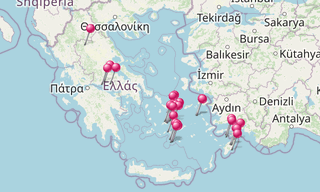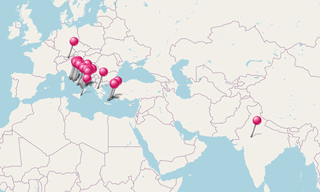The Metéora (Μετέωρα), lit. “middle of the sky”, “suspended in the air” or “in the heavens above”, is one of the largest and most important complexes of Greek Orthodox monasteries in Greece, second only to Mount Athos. The monasteries are built on natural sandstone rock pillars, at the northwestern edge of the Plain of Thessaly near the town Kalambaka. The Metéora is included on the UNESCO World Heritage Site List.
Caves in the vicinity of Metéora were inhabited continuously between 50,000 and 5,000 years ago. In the 9th century AD, an ascetic group of hermit monks moved up to the ancient pinnacles; they were the first people to inhabit Metéora since the Neolithic Era.
They lived in hollows and fissures in the rock towers, some as high as 550 m above the plain. By the late 11th and early 12th centuries, a rudimentary monastic state had formed called the Skete of Stagoi. By the end of the 12th century, an ascetic community had flocked to Metéora.
In 1344, Athanasios Koinovitis from Mount Athos brought a group of followers to Metéora. From 1356 to 1372, he founded the great Meteoron monastery on Broad Rock, which were perfect for the monks; they were safe from political upheaval and had complete control of the entry to the monastery.
The only means of reaching it was by climbing a long ladder, which was drawn up whenever the monks felt threatened. In 1517, Nectarios and Theophanes built the monastery of Varlaám, which was reputed to house the finger of St John and the shoulder blade of St Andrew.
List of the main Monasteries
- The Holy Monastery of Great Meteoron is the largest of the monasteries located at Metéora. It was erected in the mid-14th century and was the subject of restoration and embellishment projects in 1483 and 1552.
- The Holy Monastery of Varlaam is the second largest monastery in the Metéora complex. It was built in 1541 and embellished in 1548. A church, dedicated to All Saints, is in the Athonite type (cross-in-square with dome and choirs), with spacious exonarthex surrounded by a dome.
- The Holy Monastery of Rousanou / St Barbara was founded in the middle of 16th century and decorated in 1560.
- The Holy Monastery of St. Nicholas Anapausas, built in the 16th century, has a small church, decorated by the noted Cretan painter Theophanis Strelitzas, in 1527.
- The Holy Monastery of St. Stephen has a small church built in the 16th century and decorated in 1545.
- The Monastery of the Holy Trinity is on top of the cliffs. It was built in 1475 and was remodeled in 1684, 1689, 1692, 1741.

.hero.landscape.jpg?w=1600)


-Monastery-of-the-Holy-Trinity.jpg?w=256)
-Monastery-of-Varlaam.jpg?w=256)
-Monastery-of-the-Holy-Trinity.jpg?w=256)
-Holy-Asketarion.jpg?w=256)
-Monastery-of-Varlaam.jpg?w=256)
-Monastery-of-the-Holy-Trinity.jpg?w=256)
.jpg?w=256)
.jpg?w=256)
-Monastery-of-St-Stephen.jpg?w=256)
-Monastery-of-the-Holy-Trinity.jpg?w=256)
-Monastery-of-Great-Meteoron.jpg?w=256)
-Monastery-of-the-Holy-Trinity.jpg?w=256)
-Cave-of-St-George-Mandila.jpg?w=256)
-Monastery-of-Great-Meteoron.jpg?w=256)
-Monastery-of-Great-Meteoron.jpg?w=256)
-Monastery-of-Ypapantis.jpg?w=256)
-Monastery-of-Varlaam.jpg?w=256)
.jpg?w=256)
-Monastery-of-St-Nicholas-Anapausas.jpg?w=256)
-Skete-of-St-Anthony.jpg?w=256)
.jpg?w=256)
-Monastery-of-St-Stephen.jpg?w=256)
-Monastery-of-Great-Meteoron.jpg?w=256)
-Monastery-of-the-Holy-Trinity.jpg?w=256)
-Monastery-of-the-Holy-Trinity.jpg?w=256)
-Skete-of-St-Anthony.jpg?w=256)
.jpg?w=256)
.jpg?w=256)
-Monastery-of-St-Stephen.jpg?w=256)
.jpg?w=256)
-Monastery-of-Roussanou.jpg?w=256)
-Monastery-of-Varlaam.jpg?w=256)
-Monastery-of-Varlaam.jpg?w=256)
-Monastery-of-Varlaam.jpg?w=256)
.jpg?w=256)
.jpg?w=256)
-Monastery-of-the-Holy-Trinity.jpg?w=256)
-Monastery-of-Great-Meteoron.jpg?w=256)
-Monastery-of-Roussanou.jpg?w=256)
-Monastery-of-Roussanou.jpg?w=256)
-Monastery-of-Great-Meteoron.jpg?w=256)
.jpg?w=256)
.jpg?w=256)
-Monastery-of-Varlaam.jpg?w=256)
.jpg?w=256)
-Monastery-of-Ypapantis.jpg?w=256)
.jpg?w=256)
.jpg?w=256)
.hero.jpg?w=320)

-Fira.hero.jpg?w=320)

.hero.jpg?w=320)

.hero.jpg?w=320)
.map.png)